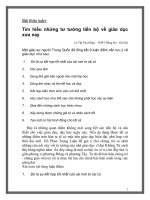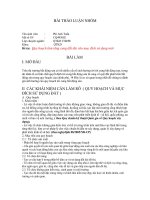Mô Hình ICEBERG Năng Lực (Tài liệu tiếng anh)
Bạn đang xem bản rút gọn của tài liệu. Xem và tải ngay bản đầy đủ của tài liệu tại đây (2.7 MB, 51 trang )
Competency
Iceberg Model
© ManagementStudyGuide.com. All rights reserved.
Objective
1
Explain what is a Competency
2
Describe the Components of
Competencies
3
Explain the Types of Competencies
4
Describe the Competency Iceberg
Model
5
Explain the Benefits of Iceberg
Model
© ManagementStudyGuide.com. All rights reserved.
Introduction
David Schneider is a highly qualified individual.
He has the right mix of skills and knowledge that
is required to work as a Sales Executive.
However, his actual job performance is nowhere
near what is expected from a man possessing
skills and knowledge that David has.
e
l
a
S
u
c
e
x
sE
His actual job performance does not match the
expected job behaviour of a man of David’s
calibre.
So, what is wrong?
Ideal candidate
What is it that makes David an ideal candidate
but stops him from actually performing on his
job?
Low job performance
© ManagementStudyGuide.com. All rights reserved.
e
v
ti
Introduction
The answer to this lies in the word ‘Competency’.
Let us learn more about ‘Competency’ and an
important model of competency, the
‘Competency Iceberg Model’.
© ManagementStudyGuide.com. All rights reserved.
Co
en mp
c y et
Competency is a combination of skills, job
attitude, and knowledge which is reflected in job
behavior that can be observed, measured and
evaluated.
Objective
1
Explain what is a Competency
2
Describe the Components of
Competencies
3
Explain the Types of Competencies
4
Describe the Competency Iceberg
Model
5
Explain the Benefits of Iceberg
Model
© ManagementStudyGuide.com. All rights reserved.
What is Competency?
efer to
r
s
e
i
c
n
e
t
Compe
that
e
g
d
e
l
w
o
n
skills or k
rior
e
p
u
s
o
t
s
lead
nce.
performa
Comp
et
abiliti encies are
that a es or cha individua
ra
re ke
l
y to e cteristics
in wo fectivene
ss
rk.
‘Competen
ce
other hand ’ on the
means the
condition
or state of
being com
petent.
re not
a
s
e
i
c
n
e
t
Compe
ly be
l
a
s
u
a
c
d
“fixed” an h efort and
d wit
develope
support.
‘Competen
t’ is when
a person is
qualified t
o perform
to a
requisite s
tandard of
the
processes
of a job.
ly at
p
p
a
n
a
cies c
n
e
t
e
p
idual,
v
i
d
Com
n
i
,
l
ationa
al and
n
o
organiz
ti
a
p
occu
d
n
a
,
m
tea
levels.
l
a
n
o
ti
func
© ManagementStudyGuide.com. All rights reserved.
What is Competency?
Some examples of competencies required by the employees are: -
Adaptability
Analytical
Reasoning
Motivation
Foresight
Commitment
Leadership
Creativity
Emotional
Stability
© ManagementStudyGuide.com. All rights reserved.
Independence
Communication
Skills
History of Competency
•
In the late 1960’s,
the Occupational
Competence
movement was
initiated by Dr. David
McClelland who was
a Professor of
Psychology at
Harvard Business
School
•
McClelland found
that traditional
tests such as
academic aptitude
and knowledge
tests, did not
predict success in
the job
•
•
Since this find and
even during the
early 70’s, leading
organizations have
been using
competencies to
help recruit, select
and manage their
outstanding
performers
A supporting
research conducted
by McClelland found
that students, who
did poor in
Universities, as long
as they passed, did
just as well in life as
the top students
© ManagementStudyGuide.com. All rights reserved.
Through this
McClelland proved
that superior
performance is not
always measured by
test scores but
rather related to
hidden traits and
qualitative
behaviours
Objective
1
Explain what is a Competency
2
Describe the Components of
Competencies
3
Explain the Types of Competencies
4
Describe the Competency Iceberg
Model
5
Explain the Benefits of Iceberg
Model
© ManagementStudyGuide.com. All rights reserved.
Kn
ow
l ed
ge
lu
Va
es
Relatively enduring
characteristics; why
and how do we
behave in a certain
way
(e.g. self-controlled
“big picture”
thinking)
How you acquire
information in a
particular field;
(e.g. Using Data based
presentation)
ge
a
m
I
–
Self
Motives
Tra
its
A learned ability; how to
The
Psychological
do the
“ what you /do”
Physiological
factors
(e.g. making an
efective
that
drive your
presentation)
behaviour
(e.g. Maslow
Pyramid of needs)
ll
Ski
Components of Competency
© ManagementStudyGuide.com. All rights reserved.
How you see yourself
(e.g. Public SpeakerConfidence)
What you consider as
important
(e.g. achieving
excellence/ ambition)
Objective
1
Explain what is a Competency
2
Describe the Components of
Competencies
3
Explain the Types of Competencies
4
Describe the Competency Iceberg
Model
5
Explain the Benefits of Iceberg
Model
© ManagementStudyGuide.com. All rights reserved.
Types of Competencies
Competencies can broadly be classified into two categories:
Basic Competencies:
They are existent in all individuals
but only their degree of existence
difers. For example, problem
solving is a competency that exists
in every individual but in varying
degrees
Competencies
Professional Competencies:
They are job related and are
above the basic competencies.
For example, handling a sales call
efectively is a competency that a
sales personnel would be required
to have
Basic
Competencies
© ManagementStudyGuide.com. All rights reserved.
Professional
Competencies
Types of Basic Competencies
The basic competencies encompass the following:
Intellectual
Competencies:
Those which
determine the
intellectual
ability of a
person.
Motivational
Competencies:
Those which
determine the
level of
motivation in an
individual.
Emotional
Competencies:
Those which
determine an
individual's
emotional
quotient.
© ManagementStudyGuide.com. All rights reserved.
Social
Competencies:
Those that
determine the
level of social
ability in a
person.
Types of Professional Competencies
The professional competencies can be classified as:
Generic Competencies:
They are those which are
considered essential for all staf,
regardless of their function or
level, that is, communication,
program execution, processing
tools, linguistic, etc. These
competencies include broad
success factors not tied to a
specific work function or
industry. They usually focus on
leadership or emotional
intelligence behaviours.
Managerial Competencies:
They are those which are
considered essential for staf
with managerial or supervisory
responsibility in any service or
program. Some examples of
managerial competencies are:
customer orientation,
organizing skills, cross
functional perspective,
planning skills, execution skills,
analytical skills, decision
making, delegation, leadership
© ManagementStudyGuide.com. All rights reserved.
Functional/Technical
Competencies:
These are specific
competencies which are
considered essential to perform
any job in the organization
within a defined technical or
functional area of work. Some
examples of
functional/technical
competencies are: business
awareness, business skills,
technical skills.
Categories of Competencies
Competencies can be divided into two categories, they are:
•
•
These are the
essential
characteristics that
everyone in the job
needs to be minimally
efective.
However, this does
not distinguish
superior from average
performers.
Threshold
ies
c
n
e
t
e
p
m
Co
Diferen
tiating
Compet
encies
â ManagementStudyGuide.com. All rights reserved.
ã
These factors
distinguish superior
from average
performers.
What is a Threshold Competency?
1
2
3
4
5
6
© ManagementStudyGuide.com. All rights reserved.
What is a Threshold Competency?
1
It is important to understand whether competencies are unique to a
particular job or whether they are generic in nature.
2
3
4
5
6
© ManagementStudyGuide.com. All rights reserved.
What is a Threshold Competency?
1
It is important to understand whether competencies are unique to a
particular job or whether they are generic in nature.
2
According to the MCBer research, twelve characteristics were
identified related to managerial efectiveness, whereas seven were
found to be threshold competencies.
3
4
5
6
© ManagementStudyGuide.com. All rights reserved.
What is a Threshold Competency?
It is important to understand whether competencies are unique to a
particular job or whether they are generic in nature.
2
According to the MCBer research, twelve characteristics were
identified related to managerial efectiveness, whereas seven were
found to be threshold competencies.
3
Every job at any level in the organization would have a threshold
competency.
4
5
6
© ManagementStudyGuide.com. All rights reserved.
What is a Threshold Competency?
It is important to understand whether competencies are unique to a
particular job or whether they are generic in nature.
According to the MCBer research, twelve characteristics were
identified related to managerial efectiveness, whereas seven were
found to be threshold competencies.
3
Every job at any level in the organization would have a threshold
competency.
4
Threshold competency is the bare minimum required to perform the
job.
5
6
© ManagementStudyGuide.com. All rights reserved.
What is a Threshold Competency?
It is important to understand whether competencies are unique to a
particular job or whether they are generic in nature.
According to the MCBer research, twelve characteristics were
identified related to managerial efectiveness, whereas seven were
found to be threshold competencies.
Every job at any level in the organization would have a threshold
competency.
4
Threshold competency is the bare minimum required to perform the
job.
5
It is summarized as a quality that a person needs in order to do a job.
6
© ManagementStudyGuide.com. All rights reserved.
What is a Threshold Competency?
It is important to understand whether competencies are unique to a
particular job or whether they are generic in nature.
According to the MCBer research, twelve characteristics were
identified related to managerial efectiveness, whereas seven were
found to be threshold competencies.
Every job at any level in the organization would have a threshold
competency.
Threshold competency is the bare minimum required to perform the
job.
5
It is summarized as a quality that a person needs in order to do a job.
6
It difers from competency, such that it does not ofer any aid in
distinguishing superior performance from average and poor
performance.
© ManagementStudyGuide.com. All rights reserved.
What are Core Competencies?
•
•
•
‘Core Competencies’ are the
competencies that help transcend
any single business event within the
organization.
It is important for organizations to
identify, develop and manage
organizational core competencies
that drive large enterprise critical
projects.
This is so because some projects are
so complex and massive that it is
impossible for a single individual to
possess the competencies required
to successfully complete a project.
© ManagementStudyGuide.com. All rights reserved.
What are Workplace Competencies?
•
•
•
‘Workplace Competencies’
focus on individuals instead of
the organization.
Therefore, workplace
competencies may vary by job
positions.
The unit of measure is people
rather than the business.
© ManagementStudyGuide.com. All rights reserved.
Core vs. Workplace Competencies
Core
Workplace
Scope
Organization
Individual
Purpose
Strategic
Tactical
Participant(s)
Business Unit
Worker
Tasks
Processes
Activities
Competencies
Global
Position
© ManagementStudyGuide.com. All rights reserved.









